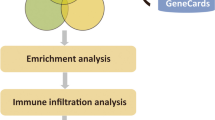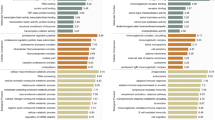Abstract
The underlying mechanism of fluorosis has not been fully elucidated. The purpose of this study was to explore the mechanism of fluorosis induced by sodium fluoride (NaF) using proteomics. Six offspring rats exposed to fluoride without dental fluorosis were defined as group A, 8 offspring rats without fluoride exposure were defined as control group B, and 6 offspring rats exposed to fluoride with dental fluorosis were defined as group C. Total proteins from the peripheral blood were extracted and then separated using liquid chromatography–tandem mass spectrometry. The identified criteria for differentially expressed proteins were fold change > 1.2 or < 0.83 and P < 0.05. Gene Ontology function annotation and Kyoto Encyclopedia of Genes and Genomes (KEGG) pathway enrichment analysis were performed using the oeCloud tool. The 177 upregulated and 22 downregulated proteins were identified in the A + C vs. B group. KEGG pathway enrichment analysis revealed that transforming growth factor-β (TGF-β) signaling pathway significantly enriched. PPI network constructed using Cytoscape confirmed RhoA may play a crucial role. The KEGG results of genes associated with fluoride and genes associated with both fluoride and inflammation in the GeneCards database also showed that TGF-β signaling pathway was significantly enriched. The immunofluorescence in HPA database showed that the main expression sites of RhoA are plasma membrane and cytosol, while the main expression site of Fbn1 is the Golgi apparatus. In conclusion, long-term NaF intake may cause inflammatory response in the peripheral blood of rats by upregulating TGF-β signaling pathway, in which RhoA may play a key role.






Similar content being viewed by others
Data Availability
During the present study, all the generated datasets and analyzed data are available from the corresponding author upon reasonable request.
References
Chouhan S, Flora SJ (2010) Arsenic and fluoride: two major ground water pollutants. Indian J Exp Biol 48(7):666–678
Singh G, Kumari B, Sinam G et al (2018) Fluoride distribution and contamination in the water, soil and plants continuum and its remedial technologies, an Indian perspective- a review. Environ Pollut 239:95–108
Zhou BH, Wei SS, Jia LS et al (2020) Drp1/Mff signaling pathway is involved in fluoride-induced abnormal fission of hepatocyte mitochondria in mice. Sci Total Environ 725:138192
Daiwile AP, Sivanesan S, Tarale P et al (2018) Role of fluoride induced histone trimethylation in development of skeletal fluorosis. Environ Toxicol Pharmacol 57:159–165
Kurdi MS (2016) Chronic fluorosis: the disease and its anaesthetic implications. Indian J Anaesth 60(3):157–162
Wei W, Pang S, Sun D (2019) The pathogenesis of endemic fluorosis: research progress in the last 5 years. J Cell Mol Med 23(4):2333–2342
Daiwile AP, Tarale P, Sivanesan S et al (2019) Role of fluoride induced epigenetic alterations in the development of skeletal fluorosis. Ecotoxicol Environ Saf 169:410–417
Morikawa M, Derynck R, Miyazono K (2016) TGF-β and the TGF-β family: context-dependent roles in cell and tissue physiology. Cold Spring Harb Perspect Biol 8(5):a021873
David CJ, Massagué J (2018) Publisher correction: contextual determinants of TGFβ action in development, immunity and cancer. Nat Rev Mol Cell Biol 19(7):479
David CJ, Massagué J (2018) Contextual determinants of TGFβ action in development, immunity and cancer. Nat Rev Mol Cell Biol 19(7):419–435
Derynck R, Budi EH (2019) Specificity, versatility, and control of TGF-β family signaling. Sci Signal 12(570):eaav5183
Flavell RA, Sanjabi S, Wrzesinski SH et al (2010) The polarization of immune cells in the tumour environment by TGFbeta. Nat Rev Immunol 10(8):554–567
Sanjabi S, Oh SA, Li MO (2017) Regulation of the immune response by TGF-β: from conception to autoimmunity and infection. Cold Spring Harb Perspect Biol 9(6):a022236
Batlle E, Massagué J (2019) Transforming growth factor-β signaling in immunity and cancer. Immunity 50(4):924–940
Tzavlaki K, Moustakas A (2020) TGF-β signaling. Biomolecules 10(3):487
Chen L, Kuang P, Liu H et al (2019) Sodium fluoride (NaF) induces inflammatory responses via activating MAPKs/NF-κB signaling pathway and reducing anti-inflammatory cytokine expression in the mouse liver. Biol Trace Elem Res 189(1):157–171
Zhao Y, Li Y, Gao Y et al (2018) TGF-β1 acts as mediator in fluoride-induced autophagy in the mouse osteoblast cells. Food Chem Toxicol 115:26–33
Thadikkaran L, Siegenthaler MA, Crettaz D et al (2005) Recent advances in blood-related proteomics. Proteomics 5(12):3019–3034
Wei Y, Zeng B, Zhang H et al (2016) iTRAQ-based proteomics analysis of serum proteins in Wistar rats treated with sodium fluoride: insight into the potential mechanism and candidate biomarkers of fluorosis. Int J Mol Sci 17(10):1644
Liu B, Fu X, Du Y et al (2023) In silico analysis of ferroptosis-related genes and its implication in drug prediction against fluorosis. Int J Mol Sci 24(4):4221
Subramanian A, Narayan R, Corsello SM et al (2017) A next generation connectivity map: L1000 platform and the first 1,000,000 profiles. Cell 171(6):1437–52.e17
Jiang Y, Chen L, Chao Z et al (2022) Ferroptosis related genes in ischemic and idiopathic cardiomyopathy: screening for potential pharmacological targets. Front Cell Dev Biol 10:817819
Sharma D, Singh A, Verma K et al (2017) Fluoride: a review of pre-clinical and clinical studies. Environ Toxicol Pharmacol 56:297–313
Jiang N, Guo F, Sun B et al (2020) Different effects of fluoride exposure on the three major bone cell types. Biol Trace Elem Res 193(1):226–233
Matsuda SS, Silva TL, Buzalaf MA et al (2014) Differential effects of fluoride during osteoblasts mineralization in C57BL/6J and C3H/HeJ inbred strains of mice. Biol Trace Elem Res 161(1):123–129
Sun MM, Beier F (2014) Chondrocyte hypertrophy in skeletal development, growth, and disease. Birth Defects Res C Embryo Today 102(1):74–82
Bros M, Haas K, Moll L et al (2019) RhoA as a key regulator of innate and adaptive immunity. Cells 8(7):733
Tian Y, Han YX, Guo HF et al (2018) Upregulated microRNA-485 suppresses apoptosis of renal tubular epithelial cells in mice with lupus nephritis via regulating the TGF-β-MAPK signaling pathway by inhibiting RhoA expression. J Cell Biochem 119(11):9154–9167
Xu H, Liu P, Liang L et al (2006) RhoA-mediated, tumor necrosis factor alpha-induced activation of NF-kappaB in rheumatoid synoviocytes: inhibitory effect of simvastatin. Arthritis Rheum 54(11):3441–3451
Deng Z, Jia Y, Liu H et al (2019) RhoA/ROCK pathway: implication in osteoarthritis and therapeutic targets. Am J Transl Res 11(9):5324–5331
Chen L, Jia P, Liu Y et al (2023) Fluoride exposure disrupts the cytoskeletal arrangement and ATP synthesis of HT-22 cell by activating the RhoA/ROCK signaling pathway. Ecotoxicol Environ Saf 254:114718
Shusterman K, Gibson CW, Li Y et al (2014) Wnt-RhoA signaling pathways in fluoride-treated ameloblast-lineage cells. Cells Tissues Organs 199(2–3):159–168
Yang E, Jeon SB, Baek I et al (2010) Fluoride induces vascular contraction through activation of RhoA/Rho kinase pathway in isolated rat aortas. Environ Toxicol Pharmacol 29(3):290–296
Tiedemann K, Boraschi-Diaz I, Rajakumar I et al (2013) Fibrillin-1 directly regulates osteoclast formation and function by a dual mechanism. J Cell Sci 126(Pt 18):4187–4194
Yu H, Jiang N, Yu X et al (2018) The role of TGFβ receptor 1-smad3 signaling in regulating the osteoclastic mode affected by fluoride. Toxicology 393:73–82
Zhang J, Jiang N, Yu H et al (2019) Requirement of TGFβ signaling for effect of fluoride on osteoblastic differentiation. Biol Trace Elem Res 187(2):492–498
Chen G, Deng C, Li YP (2012) TGF-β and BMP signaling in osteoblast differentiation and bone formation. Int J Biol Sci 8(2):272–288
Yan X, Dong N, Hao X et al (2019) Comparative transcriptomics reveals the role of the Toll-like receptor signaling pathway in fluoride-induced cardiotoxicity. J Agric Food Chem 67(17):5033–5042
Tang H, Wang M, Li G et al (2023) Association between dental fluorosis prevalence and inflammation levels in school-aged children with low-to-moderate fluoride exposure. Environ Pollut 320:120995
Ding XJ, Zhang ZY, Jin J et al (2020) Salidroside can target both P4HB-mediated inflammation and melanogenesis of the skin. Theranostics 10(24):11110–11126
Gao S, Cheng QC, Hu YG et al (2021) LncRNA AK148321 alleviates neuroinflammation in LPS-stimulated BV2 microglial cell through regulating microRNA-1199-5p/HSPA5 axis. Life Sci 266:118863
Yang JQ, Kalim KW, Li Y et al (2019) Rational targeting Cdc42 restrains Th2 cell differentiation and prevents allergic airway inflammation. Clin Exp Allergy 49(1):92–107
Li Y, Wang Z, Li J, et al (2023) Sodium butyrate ameliorates fluorosis-induced neurotoxicity by regulating hippocampal glycolysis in vivo. Biol Trace Elem Res (Online ahead of print)
Angwa LM, Jiang Y, Pei J et al (2022) Antioxidant phytochemicals for the prevention of fluoride-induced oxidative stress and apoptosis: a review. Biol Trace Elem Res 200(3):1418–1441
Song C, Shi D, Chang K et al (2021) Sodium fluoride activates the extrinsic apoptosis via regulating NOX4/ROS-mediated p53/DR5 signaling pathway in lung cells both in vitro and in vivo. Free Radic Biol Med 169:137–148
Wang Y, Li A, Mehmood K et al (2021) Long-term exposure to the fluoride blocks the development of chondrocytes in the ducks: the molecular mechanism of fluoride regulating autophagy and apoptosis. Ecotoxicol Environ Saf 217:112225
Bergandi L, Aina V, Garetto S et al (2010) Fluoride-containing bioactive glasses inhibit pentose phosphate oxidative pathway and glucose 6-phosphate dehydrogenase activity in human osteoblasts. Chem Biol Interact 183(3):405–415
Funding
This work was supported by the National Natural Scientific Foundation of China (82003400, 81972981) and the Science and Technology Program of Henan Province (232102311079, 212102310622).
Author information
Authors and Affiliations
Contributions
Fang-fang Yu: methodology, writing, review and editing, and funding acquisition. Shui-yuan Yu, Lei-zhen Duan, and Shuo Yang: data curation, visualization, and writing, original draft. Xiang-bo Hou, Yu-hui Du, Ming-hui Gao, Juan Zuo, and Lei Sun: investigation, visualization, and data curation. Xiao-li Fu, Hui Huang, Zhi-yuan Li, Guo-yu Zhou, Dao-li Jia, Rui-qin Chen, and Yue Ba: supervision, resources, and writing, review and editing.
Corresponding author
Ethics declarations
Ethics Approval
All animal studies were reviewed and approved by the animal ethics research committee of Zhengzhou University.
Competing Interests
The authors declare no competing interests.
Additional information
Publisher's Note
Springer Nature remains neutral with regard to jurisdictional claims in published maps and institutional affiliations.
Supplementary Information
Below is the link to the electronic supplementary material.
Rights and permissions
Springer Nature or its licensor (e.g. a society or other partner) holds exclusive rights to this article under a publishing agreement with the author(s) or other rightsholder(s); author self-archiving of the accepted manuscript version of this article is solely governed by the terms of such publishing agreement and applicable law.
About this article
Cite this article
Yu, Ff., Yu, Sy., Duan, Lz. et al. Proteomics Sequencing Reveals the Role of TGF-β Signaling Pathway in the Peripheral Blood of Offspring Rats Exposed to Fluoride. Biol Trace Elem Res 202, 2100–2110 (2024). https://doi.org/10.1007/s12011-023-03805-x
Received:
Accepted:
Published:
Issue Date:
DOI: https://doi.org/10.1007/s12011-023-03805-x




